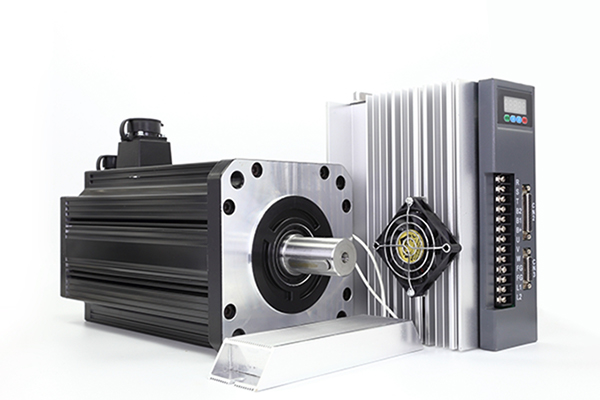Home » Servo System » What is the Bandwidth of Servomechanism?
What is the Bandwidth of Servomechanism?
For a servo system, the bandwidth is the maximum sine wave frequency to which the servo system can respond. In professional terms, it is the frequency at which the amplitude response decays to -3dB, or the frequency at which the phase response lags by 90 degrees. Here are a few basic concepts:
1. Frequency components of a signal. Any signal is made up of a superposition of a finite or infinite number of sinusoidal signals with different frequencies, which are the frequency components of the signal. As an example, a square wave signal can be decomposed into an infinite number of sinusoids of different frequencies, as shown in Figure 1, which are the frequency components that make it up. These frequency components are superimposed one on top of the other starting from the lower frequencies, and the superposition process is shown in Figure 2. If the square wave passes through a system with infinite bandwidth, then all frequency components can pass through smoothly and the square wave will be reproduced without distortion. If a square wave passes through a system with a limited bandwidth, the frequency components outside the bandwidth will be lost and the square wave will be distorted. The larger the bandwidth, the fewer frequency components will be lost and the less distortion will occur.


2. Decibel. The decibel is used as a unit of measure of gain (amplification) and is a ratio with no scale. For amplitude-type variables, take the logarithm of the amplification (bottoming out at 10) and multiply it by 20 to get the gain described in decibels. Thus, -3dB is actually 0.707 times, and the two are the same thing.
3. Gain. This is actually the magnification, a dimensionless number often expressed in decibels.
4. Bode plot (logarithmic frequency response plot). Bode plot is used to describe the frequency response characteristics of the system diagram, its horizontal axis is the frequency, the vertical axis is the gain (that is, amplification) or phase, axis scale in logarithmic coordinates. A typical Bode plot is shown in Figure 3.

Figure3
A servo is also a signaling system and can be thought of as a low-pass filter. It always lets the lower frequency components through and attenuates the higher frequency parts. Therefore, the wider the bandwidth, the better the servo system's output can follow the input commands, and the better the system's dynamic performance.
In order to be stricter and more operable, the test method of servo drive bandwidth is stipulated: the drive inputs sinusoidal speed command, the amplitude of which is 0.01 times of the commanded value of rated speed, and the frequency is gradually increased from 1Hz to record the corresponding speed curve of the motor, and as the commanded sinusoidal frequency is increased, the phase lag of the waveform curve of the motor speed to the commanded sinusoidal curve is gradually increased and the amplitude of the waveform curve gradually The amplitude gradually decreases. The frequency at which the phase lag increases to 90 degrees is taken as the bandwidth of the 90-degree phase shift of the servo system; the frequency at which the amplitude decreases to 0.707 times the frequency at the low frequency is taken as the bandwidth of the servo system at -3dB.
A servo system is a multi-closed-loop nested control system with three control loops, from the inside out, the current loop, the speed loop and the position loop, and its bandwidth decreases in that order. In addition, many servo drive products have a variety of operating modes, can be set to high dynamic performance mode, high-precision mode, etc., even with the same servo drive, if the settings are different, the system's bandwidth is not the same. Meanwhile, We also need to know some tips for using the servo drive.
1. Frequency components of a signal. Any signal is made up of a superposition of a finite or infinite number of sinusoidal signals with different frequencies, which are the frequency components of the signal. As an example, a square wave signal can be decomposed into an infinite number of sinusoids of different frequencies, as shown in Figure 1, which are the frequency components that make it up. These frequency components are superimposed one on top of the other starting from the lower frequencies, and the superposition process is shown in Figure 2. If the square wave passes through a system with infinite bandwidth, then all frequency components can pass through smoothly and the square wave will be reproduced without distortion. If a square wave passes through a system with a limited bandwidth, the frequency components outside the bandwidth will be lost and the square wave will be distorted. The larger the bandwidth, the fewer frequency components will be lost and the less distortion will occur.

Figure 1

Figure 2
2. Decibel. The decibel is used as a unit of measure of gain (amplification) and is a ratio with no scale. For amplitude-type variables, take the logarithm of the amplification (bottoming out at 10) and multiply it by 20 to get the gain described in decibels. Thus, -3dB is actually 0.707 times, and the two are the same thing.
3. Gain. This is actually the magnification, a dimensionless number often expressed in decibels.
4. Bode plot (logarithmic frequency response plot). Bode plot is used to describe the frequency response characteristics of the system diagram, its horizontal axis is the frequency, the vertical axis is the gain (that is, amplification) or phase, axis scale in logarithmic coordinates. A typical Bode plot is shown in Figure 3.

Figure3
A servo is also a signaling system and can be thought of as a low-pass filter. It always lets the lower frequency components through and attenuates the higher frequency parts. Therefore, the wider the bandwidth, the better the servo system's output can follow the input commands, and the better the system's dynamic performance.
In order to be stricter and more operable, the test method of servo drive bandwidth is stipulated: the drive inputs sinusoidal speed command, the amplitude of which is 0.01 times of the commanded value of rated speed, and the frequency is gradually increased from 1Hz to record the corresponding speed curve of the motor, and as the commanded sinusoidal frequency is increased, the phase lag of the waveform curve of the motor speed to the commanded sinusoidal curve is gradually increased and the amplitude of the waveform curve gradually The amplitude gradually decreases. The frequency at which the phase lag increases to 90 degrees is taken as the bandwidth of the 90-degree phase shift of the servo system; the frequency at which the amplitude decreases to 0.707 times the frequency at the low frequency is taken as the bandwidth of the servo system at -3dB.
A servo system is a multi-closed-loop nested control system with three control loops, from the inside out, the current loop, the speed loop and the position loop, and its bandwidth decreases in that order. In addition, many servo drive products have a variety of operating modes, can be set to high dynamic performance mode, high-precision mode, etc., even with the same servo drive, if the settings are different, the system's bandwidth is not the same. Meanwhile, We also need to know some tips for using the servo drive.
Post a Comment:
You may also like:

Category
Featured Articles
What are the Basic Components of ...
 Servomechanisms, called servos for short, are the basic building blocks of power drives. In this manual what we mean by a power ...
Servomechanisms, called servos for short, are the basic building blocks of power drives. In this manual what we mean by a power ...
 Servomechanisms, called servos for short, are the basic building blocks of power drives. In this manual what we mean by a power ...
Servomechanisms, called servos for short, are the basic building blocks of power drives. In this manual what we mean by a power ...What is Servo System?
 A feedback control system used to precisely follow or reproduce a process. Also known as a follower system. In many cases, a ...
A feedback control system used to precisely follow or reproduce a process. Also known as a follower system. In many cases, a ...
 A feedback control system used to precisely follow or reproduce a process. Also known as a follower system. In many cases, a ...
A feedback control system used to precisely follow or reproduce a process. Also known as a follower system. In many cases, a ...What Should Consider Before Using ...
 Servo system is a commonly used control system, widely used in industrial automation. It compares the output signal with the ...
Servo system is a commonly used control system, widely used in industrial automation. It compares the output signal with the ...
 Servo system is a commonly used control system, widely used in industrial automation. It compares the output signal with the ...
Servo system is a commonly used control system, widely used in industrial automation. It compares the output signal with the ...What is the Bandwidth of ...
 For a servo system, the bandwidth is the maximum sine wave frequency to which the servo system can respond. In professional ...
For a servo system, the bandwidth is the maximum sine wave frequency to which the servo system can respond. In professional ...
 For a servo system, the bandwidth is the maximum sine wave frequency to which the servo system can respond. In professional ...
For a servo system, the bandwidth is the maximum sine wave frequency to which the servo system can respond. In professional ...